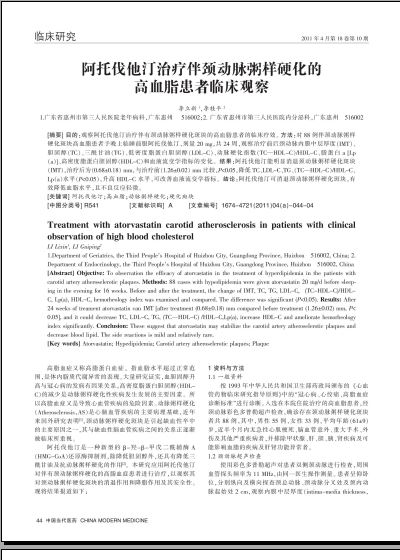阿托伐他汀治疗伴颈动脉粥样硬化的高血脂患者临床观察(1)
 |
| 第1页 |
参见附件(3128KB,3页)。
[摘要] 目的:观察阿托伐他汀治疗伴有颈动脉粥样硬化斑块的高血脂患者的临床疗效。方法:对88例伴颈动脉粥样硬化斑块高血脂患者予晚上临睡前服阿托伐他汀,剂量20 mg,共24周,观察治疗前后颈动脉内膜中层厚度(IMT)、胆固醇(TC)、三酰甘油(TG)、低密度脂蛋白胆固醇(LDL-C)、动脉硬化指数(TC—HDL-C)/HDL-C、脂蛋白a [Lp(a)]、高密度脂蛋白胆固醇(HDL-C)和血液流变学指标的变化。结果:阿托伐他汀能明显消退颈动脉粥样硬化斑块(IMT),治疗后为(0.68±0.18) mm,与治疗前(1.26±0.02) mm比较,P<0.05,降低TC、LDL-C、TG、(TC—HDL-C)/HDL-C、Lp(a)水平(P<0.05),升高HDL-C 水平,可改善血液流变学指标。结论:阿托伐他汀可消退颈动脉粥样硬化斑块,有效降低血脂水平,且不良反应轻微。
[关键词] 阿托伐他汀;高血脂;动脉粥样硬化;硬化斑块
[中图分类号] R541 [文献标识码]A[文章编号]1674-4721(2011)04(a)-044-04
Treatment with atorvastatin carotid atherosclerosis in patients with clinical observation of high blood cholesterol
LI Lixin1, LI Guiping2
1.Department of Geriatrics, the Third People′s Hospital of Huizhou City, Guangdong Province, Huizhou 516002, China; 2. Department of Endocrinology, the Third People′s Hospital of Huizhou City, Guangdong Province, Huizhou 516002, China
[Abstract] Objective: To observation the efficacy of atorvastatin in the treatment of hyperdipidemia in the patients with carotid artery atheroselerotic plaques. Methods: 88 cases with hypedipidemia were given atorvastatin 20 mg/d before sleeping in the evening for 16 weeks. Before and after the treatment, the change of IMT, TC, TG, LDL-C, (TC-HDL-C)/HDL-C, Lp(a), HDL-C, hemorheology index was examined and compared. The difference was significant (P<0.05). Results: After 24 weeks of treament atorvastatin can IMT [after treatment (0.68±0.18) mm compared before treatment (1.26±0.02) mm, P<0.05], and it could decrease TC, LDL-C, TG, (TC—HDL-C) /HDL-C,Lp(a), increase HDL-C and ameliorate hemorheology index significantly. Conclusion: These suggest that atorvastatin may stabilize the carotid artery atheroselerotic plaques and decrease blood lipid. The side reactions is mild and relatively rare.
[Key words] Atorvastatin; Hypedipidemia; Carotid artery atheroselerotic plaques; Plaque
高脂血症又称高脂蛋白血症,指血脂水平超过正常范围,是体内脂质代谢异常的表现。大量研究证实,血胆固醇升高与冠心病的发病有因果关系,高密度脂蛋白胆固醇(HDL-C)的减少是动脉粥样硬化性疾病发生发展的主要因素。所以高脂血症又是导致心血管疾病的危险因素。动脉粥样硬化(Atherosclerosis,AS)是心脑血管疾病的主要病理基础,近年来国外研究表明[1],颈动脉粥样硬化斑块是引起缺血性卒中的主要原因之一,其与缺血性脑血管疾病之间的关系正逐渐被临床所重视。
阿托伐他汀是一种新型的β-羟-β-甲戊二酰辅酶A(HMG-CoA)还原酶抑制剂 ......
您现在查看是摘要介绍页,详见PDF附件(3128KB,3页)。